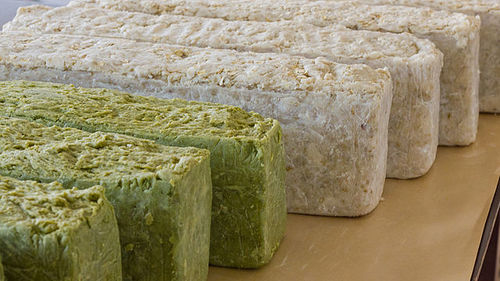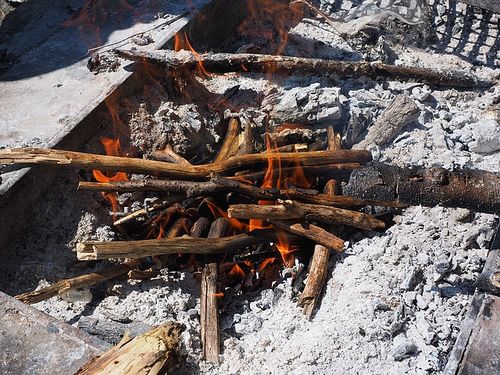Wood Ash

Wood ash is the powder left over after the combustion of wood. Typically, between 0.43 and 1.82 percent of the mass of burned wood (dry basis) results in ash.
Many uses
- fertilizer or soil conditioner (due to potassium and calcium carbonate)
- other uses in gardening: for plants that like alkaline soil; as a slug/snail repellent
- in hydroponic solutions
- seed preservation
- food preservation: preserve fruits and vegetables; also, "immortal eggs"
- as a compost additive (reduces smells)
- pottery (for glaze)
- soap making (see: lye)
- melt ice (eco-friendly alternative to salt)
- mix ash and water to remove stains from furniture
- make toothpaste (see recipe)
- polish metal
Extraction of minerals
Wood ash contains many minerals that can be separated out for further use. A major component is calcium carbonate, representing 25 or even 45 percent (depending on feedstock and burn conditions). Less than 10 percent is potash, and less than 1 percent phosphate; there are trace elements of iron, manganese, zinc, copper and some heavy metals. However, these numbers vary, as combustion temperature is an important variable in determining wood ash composition. All of these are, primarily, in the form of oxides.
Here is a brief protocol via Caveman Chemistry:
If we add the ashes to water, the soluble potassium and sodium salts will dissolve while the insoluble silica and calcium carbonate will settle to the bottom. We can then drain off the water (containing the "good stuff") and throw the insoluble material away. To separate the chlorides from the soluble carbonates, we will exploit the greater solubility of the carbonates in hot water. We will bring the liquid to a boil and continue boiling until enough water boils away for an insoluble precipitate to form. This is very likely a mixture of sodium and potassium chloride. From this point, we will continue boiling until half of the remaining water is removed.
At this point we can be reasonably certain that only the soluble carbonates remain in solution. We will carefully pour off the hot liquid into another container, leaving the solid material behind. As the liquid cools to room temperature, the less soluble sodium carbonate will precipitate leaving the more soluble potassium carbonate in solution. Finally, the remaining solution can be drained off and boiled to dryness, producing solid potassium carbonate.
One of the observations you make should be that it takes a lot of wood to make a little ash and a lot of ash to make a little potash. Thus, while it is not particularly difficult to extract potash from wood, you will go through an enormous amount of wood to produce commercial amounts (pounds and tons) of potash.
Biomining from Ash
Biomining is sometimes performed on ash. A plant that is known to concentrate the mineral of interest is first grown on low-grade ore. It is then burned, thereby concentrating the mineral. Bioleaching is then performed on the ash, using special microbes.
Links
- Permaculture Magazine: "At Least 10 Uses for Wood Ash"
- http://www.naturallivingideas.com/wood-ash-uses/
- The Sustainable Smallholding: "Wood ash and soil fertility"
